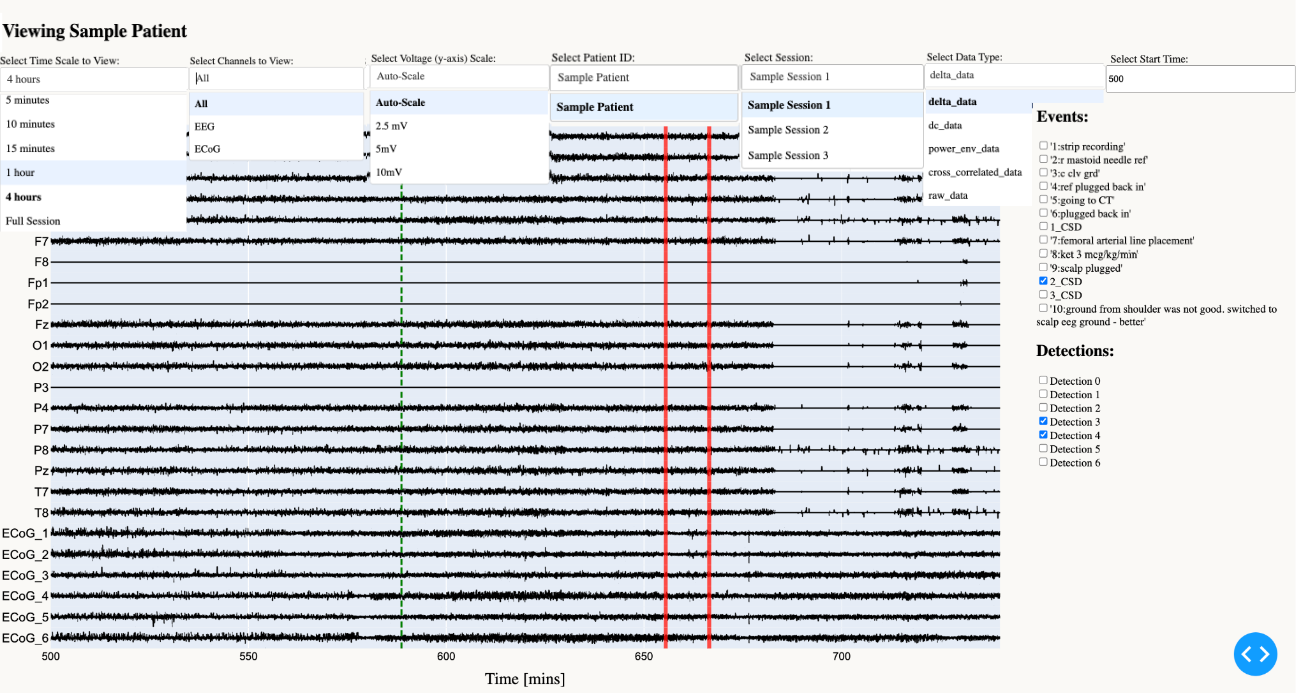Smart EEG
Novel Algorithms WAVEFRONT[TM] and SilenceMap[TM] enable automatic detection of “Neural Silences” following brain injury, leading to high precision patient care
What are algorithms?
Algorithms are procedures written to discover and identify statistical patterns in large groups of data. Machine learning uses these programmed algorithms to receive data, analyze it, and predict potential outcomes which helps solve complex problems accurately and efficiently.
At Precision Neurscopics, we’ve developed algorithms to detect activity (or lack thereof) which can be indicative of brain injury. Using algorithms to assist in patient treatment increases patient access to potentially lifesaving medical care.
WAVEFRONT is the world’s first algorithm for automatically detecting Cortical Spreading Depolarizations (CSDs) using non-invasive brain recordings from electroencephalogram (EEG) signals.
-
CSD’s are defined as decreases in the brain’s standard electrical activity, and are common after Traumatic Brain Injuries. An example is shown on the left.
-
Reliable CSD detection is critical, specifically for TBI patients, as CSD occurrence and frequency can be read as biomarkers by clinicians to determine appropriate treatment.
-
Currently, CSDs are detected manually, and are generally found using invasively recorded Electrocorticography (ECoG) signals. ECoG has limited spatial coverage, and its invasive nature leads to increased time and resource costs to hospitals. The introduction of an automated EEG-based method for detecting CSDs will lead to increased detection rates and improved patient outcomes, while simultaneously decreasing time and cost strains on healthcare networks.
WAVEFRONT[TM] Detection Algorithm
WAVEFRONT[TM] is now available for download on GitHub!
Click here to download WAVEFRONT[TM]
Introducing the first Graphical User Interface built around WAVEFRONT[TM]
This GUI allows users to use the WAVEFRONT Algorithm in a user-friendly, and intuitive manner. This GUI is built similarly to existing eeg analysis platforms, for seamless integration into existing workflows, while displaying algorithm outputs clearly and intuitively. By displaying the temporal detection information in parallel with the data, end users have full transparency regarding how the algorithm reaches its results.
Additionally, our team is developing an ONLINE version of WAVEFRONT, identical to our OFFLINE version. This version is useful for comparing algorithmic results to existing methods and analyzing existing data sets.
In this example of our OFFLINE version, the dotted green line represents a ‘Ground Truth’ CSD determined by existing methodologies (time-intensive ECoG analysis performed by trained specialists). The red lines represent automated CSD detections from WAVEFRONT.
Our ONLINE version will be able to perform the exact sample processing and analysis shown as our OFFLINE version but is designed for analyzing live data streams. This version will allow for optimizing the pipeline to accommodate a continuous input of data and will allow for rapid integration into existing care settings.
SilenceMap is a novel algorithm which allows for rapid detection of Neural Silences using cost-effective electroencephalogram (EEG) signals.
-
Similar to CSD’s, Neural Silences are defined as decreases in the brain’s standard electrical activity, and are common after Traumatic Brain Injuries. Unlike CSD’s, Neural Silences typically do not move.
-
Detecting and localizing these regions typically require expensive and time-consuming imaging devices (e.g. MRI Machines). This results in a limited number of patients being scanned, and inequity of medical care in clinical settings where such devices are not available. The use of EEG signals allows for faster, more equitable, and more cost-effective methods of detecting Neural Silences.
-
When compared to similar methodologies, SilenceMap showed significantly better localization performance. SilenceMap will bring improved care to more patients, while lowering time and costs for care providers.




